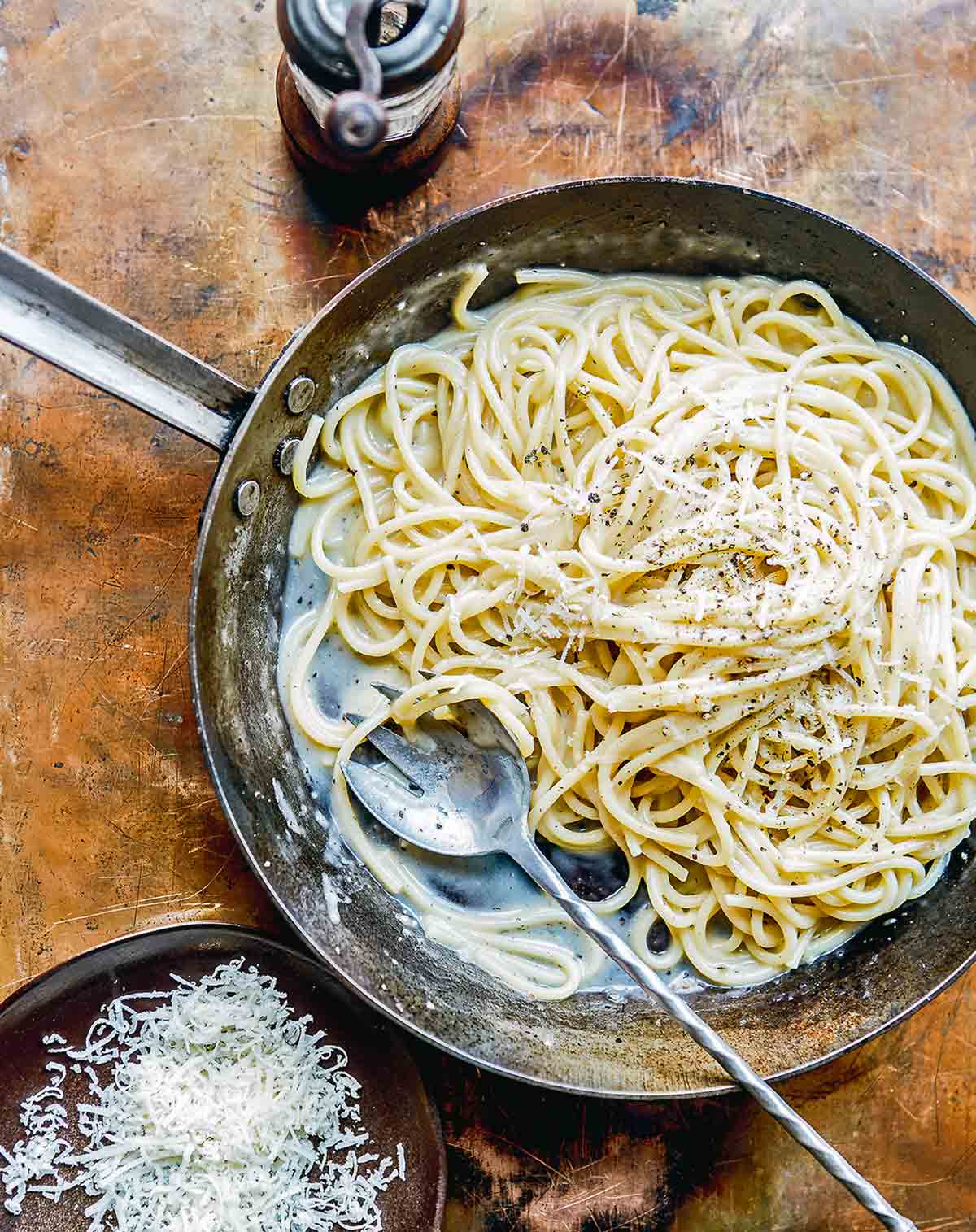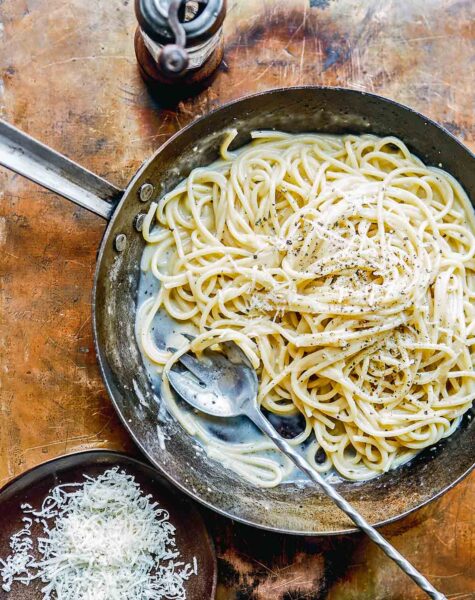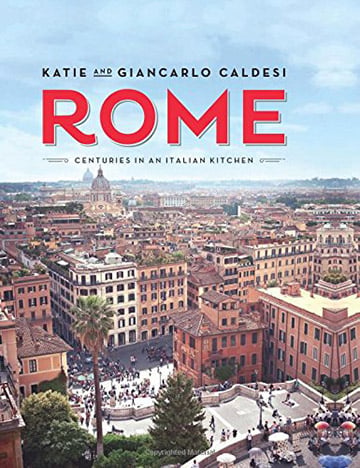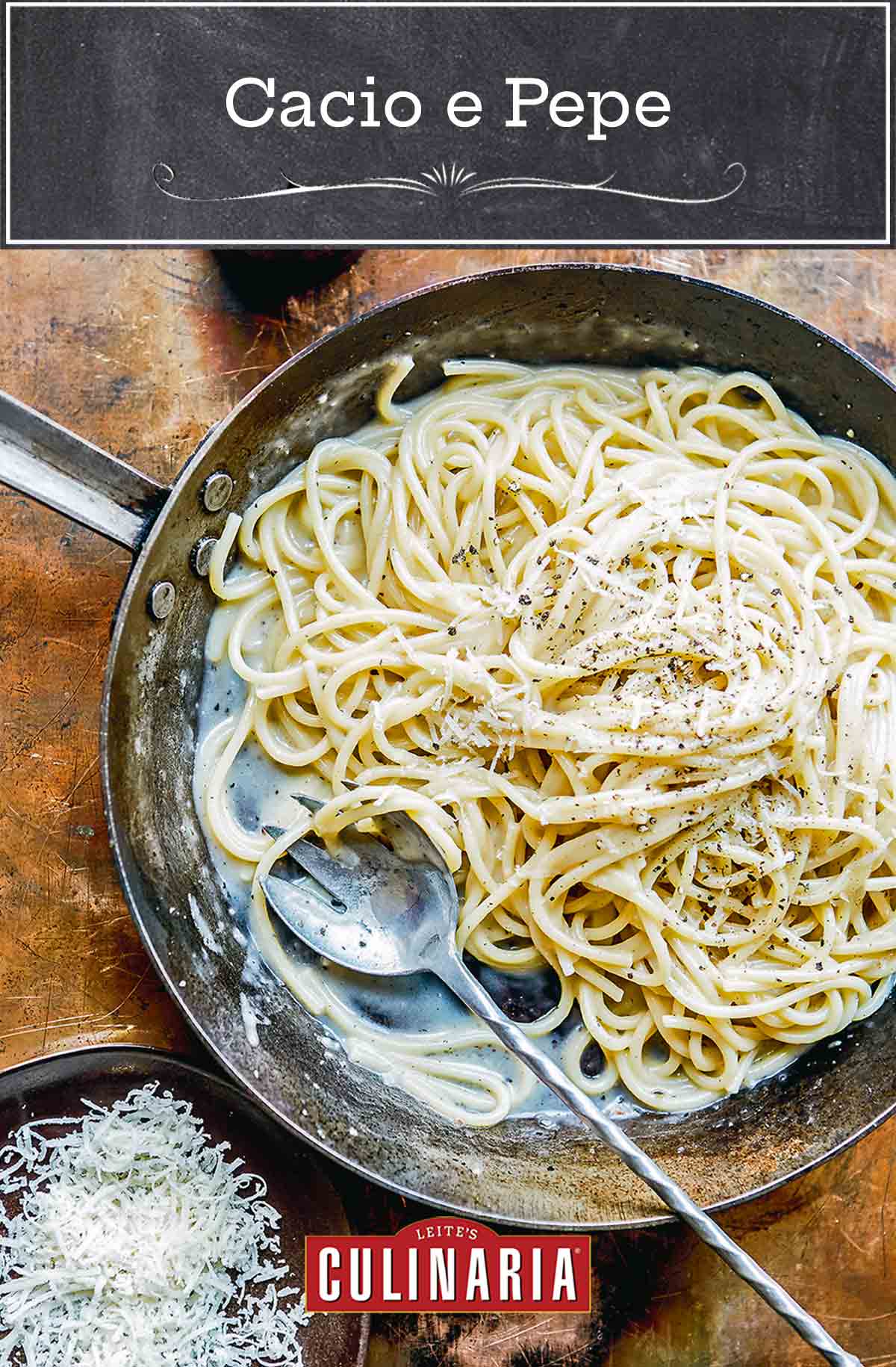
“There are many ways to make this classic dish of cacio e pepe and each Roman cook will show you some slightly different ways to manipulate pasta, cheese, and pepper into a wonderful, warm bowl of comfort food.” So begins this seemingly unassuming recipe for authentic cacio e pepe. But when you peruse the instructions, that’s when the magic truly begins.
The cacio e pepe pasta relies on a method known as “risotato,” so-called because it is like making a risotto. The pasta is cooked not in a pot of salted water but in a frying pan just large enough to contain the spaghetti. As the cooking water is absorbed by the pasta the liquid in the pan reduces and becomes the sauce. And that’s just in theory. Wait’ll you taste it.–David Leite
Cacio e Pepe FAQs
Yeah, we get tongue-tied sometimes, too. Here’s the phonetic pronunciation kaa·choh ee peh·pay And here’s an Italian speaking it for you.
This recipe specifically calls for cacio de Roma (literally Roman cheese). And since cacio de pepe is a quintessential Roman dish, you’d do well to find some. It’s a semi-soft sheep’s cheese from Lazio (the region of Italy that encompasses the province of Rome).
While a hard cheese won’t give you quite the same result, there are substitutions. Most of our testers were unable to find cacio de Roma without specially ordering it, so if you find yourself in the same situation, you can use pecorino Romano (a hard sheep’s milk cheese) instead. Failing that, Parmigiano-Reggiano makes an acceptable choice as well
Although it’s not traditional, our testers had success making this with linguine, bucatini, penne, and gluten-free pasta.

Cacio e Pepe
Ingredients
- 3 tablespoons extra-virgin olive oil
- 1/2 to 1 teaspoon freshly ground black pepper
- 11 1/2 ounces fresh tonnarelli or dried spaghetti
- Generous pinch salt
- 4 1/4 to 5 cups boiling water or exceptionally hot tap water
- 3 1/2 ounces cacio de Roma, finely grated [See FAQ above]
Instructions
- Grab your largest saucepan (you want it to be around 12 inches or 30 centimeters in diameter or large enough for the spaghetti to lie in a single layer) and place it over medium heat. Add the oil and pepper and heat until you can smell the heady spice of the pepper, about 2 minutes.
- Add the spaghetti to the pan along with the salt and about 2 cups (16 fluid ounces) of water. You'll want to watch out as the water may sputter when added to the hot oil. Add the remaining 2 1/4 cups (18 fluid ounces) hot water, little by little, as you would with risotto—that is to say, add a ladleful of hot water and cook, stirring frequently, until the liquid is almost but not completely absorbed before adding another ladleful of water.
- Repeat until the spaghetti is al dente and the water has reduced to a soupy consistency, 8 to 10 minutes. If the pasta starts to look dry, add a little more water but no more than a total of 5 cups (40 fluid ounces).
- While the pasta is cooking, warm some bowls in a low oven. (Don't ignore this step. It helps ensure the creamy sauce clinging to the pasta doesn't turn to clumps.)
- When the pasta is ready, remove the pan from the heat and add the cheese, a little at a time, stirring furiously and constantly, until a smooth and creamy sauce forms. Serve the cacio e pepe straight away in the hot bowls.

Nutrition
Nutrition information is automatically calculated, so should only be used as an approximation.
Recipe Testers’ Reviews
Wowee! I’ll be making this authentic cacio e pepe recipe again and again. Completely surprised by the easy method and the taste—both are fabulous. It’s the dish to make when you think there’s no food in the house. A few simple ingredients, paired with a glass of wine, and voilà—you have a fancy dinner!
I used pecorino Romano cheese. We had some leftovers, and they reheated okay in the microwave with a drizzle of olive oil and a quick stir after a minute or so.
To be honest, I didn’t think this easy cacio e pepe recipe would work. But it’s genius. The pasta was perfectly cooked. The sauce was super creamy and tasty. And all done in 10 minutes.
I’m in love! It took me about 8 minutes to cook the pasta, but I used fresh pasta (linguini by Bertolli ). I boiled water in the electric kettle, and in the meanwhile roasted the fresh ground pepper (I used a tricolored pepper) in the olive oil. Added the fresh pasta and a cup of boiling water. Stirred every minute or so, adding more water. After 8 minutes, the pasta was perfect. Added about 1/2 cup additional hot water and the cheese and stirred fiercely with a wooden spoon for about 30 seconds. Done.
Perfect creamy sauce, coating the pasta nicely. The cheese I used was a young Reggiano. Love it and will give it a try with carbonara. The 4 servings are accurate, especially when you use it as a pasta course in an Italian meal.
This cacio e pepe was really delicious and a breeze to put together for a quick weeknight meal with some sautéed kale on the side.
My only issue was the amount of pepper in the recipe was a little overwhelming. And I like pepper. I’d suggest perhaps starting with half the amount and adding to the finished dish to taste. I used pecorino Romano cheese, finely grated.
The timing was perfect—at 10 minutes, there was just enough liquid left in the pan to make a smooth sauce, no extra water needed. The pasta was still al dente, and when the cheese was slowly added, stirring constantly, it produced a very smooth sauce. Even as it cooled, the sauce stayed smooth.
This is a delicious and very simple pasta dish. It doesn’t mean that you don’t need to pay careful attention, though. I added about half the water at once, then added smaller amounts throughout the cooking process in order to achieve a creamy base.
I was able to find a semi-soft pecorino, although it wasn’t cacio de Roma, and it melted beautifully into the spaghetti. A nice creamy sauce was achieved, with plenty to go around for 4 plates. This is where you need to pay attention to the sauciness of the dish and add more water if need be. I am not sure how using Parmesan or regular aged pecorino would translate here, as both are much harder cheeses and don’t melt as well. I used a little more water than called for, and my actual cooking time was closer to 12 minutes.
My other concern was that perhaps 1 teaspoon freshly ground pepper was not going to be enough. This was after researching other recipes that called for anywhere up to 4 tablespoons. I stuck with 1 teaspoon, and it was perfect—plenty of heat but not one person out of 4 diners thought it was too much. I served this along with a heaping bowl of charred greens—kale, chard, broccoli, and zucchini. The strong flavors of the greens really helped contrast with the quiet flavors in this dish, and I recommend this pairing!
Carbs and sauce—a basic combination that makes so many satisfying meals we love. Even better when the combo can be prepared in a flash, and this pasta dish is exactly that.
I tested this recipe twice, and cheese seems to be the defining ingredient here. I made a 50/50 blend of pecorino Romano and Parmigiano-Reggiano (both hard) for the first test and used cacio de Roma (semi-soft) the second time. The latter was the clear winner for me. The sauce was remarkably creamier and the flavor was rounder—like a silky béchamel—and an excellent cushion for the abundant black pepper.
The hard cheeses worked fine, but I found them a bit too sharply salty for this dish, and the sauce wasn’t quite as smooth. Another finding: very hot tap water worked just as well as boiling water. A one-pan/one-burner dinner for four—what home cook wouldn’t love that?! Oh, absolutely do serve this with bread so none of the sauce goes to waste.
I used Barilla thick spaghetti, and the cooking time on the package was 11 minutes. It took an extra minute for the pasta to cook to al dente, probably because of the small amount of water it was cooked in (no room for the pasta to “swim” in rolling water). If I had used regular spaghetti (cooking time: 9 minutes), I suspect it would have taken 10 minutes as stated in the recipe. This recipe feeds 3 to 4 people.
In thinking about another substitute for cacio de Roma (I wasn’t crazy about the results the two hard cheeses yielded), pecorino Toscano might be a good one. I didn’t test it in this recipe, so I’m only guessing. It’s another semi-soft sheep’s milk cheese (has to be young; aged one is hard & crumbly) with a round soft flavor. It’s sold at the market where I shop, and the price is about the same as cacio de Roma.
This authentic cacio e pepe recipe transports me to Da Felice in Rome where I first tasted cacio e pepe surrounded by locals enjoying an evening out. It’s so easy and so comforting that it should be added to your repertory, immediately. I like to warm the bowls by letting them rest beside my cooking pan on the gas top. Although I have a difficult time finding cacio de Roma cheese, Parmigiano Reggiano is a lovely substitute.
For those who are gluten-free, this recipe works beautifully with gluten-free pasta, Bonta d’Italia being my favorite. Should you want a meatier, albeit not quite authentic, version try adding a bit of speck or thickly sliced prosciutto. I won’t tell.
















This cacio e pepe highlights just how elegant a simple classic Italian dish can be. “Cheese and pepper pasta” sounds too simple, something destined for the kids’ menu at your local family restaurant. The resulting dish here, after relatively minimal work, is so much more than that simple title. Here you have the bite from the black pepper (more than most people would use for any recipe). The sharp funk from the cheese (I couldn’t find cacio de Roma, so I used pecorino Romano, figuring I should at least stick with sheep’s milk cheese).\
The cooking method, unusual but very doable, is what takes these sparse ingredients and transforms them into something silky, delicate, and downright lovely. It’s too easy and a great new way to cook pasta while retaining that excellent starchy water for a sauce. Because the water was thickened with the starch, it really lent itself to creating a silky coating once the cheese was mixed in.
While this technique required a little bit more elbow grease, the overall time spent with this recipe was so short. I wouldn’t hesitate to cook pasta in this manner again (read: beginner-friendly.) If one were feeling a bit more daring and adventurous, a shower of shaved black truffle would elevate this dish to the level of sublime, just saying…
Mackenzie, you captured the wonder that is cacio e pepe! It really is incredible how a few humble ingredients—cheese, pepper, pasta, and water—can come together to create something so luxurious.
I love that you embraced the sheep’s milk pecorino Romano, and you’re absolutely right—the starch-thickened water is key to achieving that silky, delicate coating.
And I love the idea of shaved black truffle—now that would be next-level sublime! Thanks for sharing your insights and for giving this technique a try. Hope it stays in your rotation!
This authentic cacio e pepe is a surprisingly simple and delicious pasta. Perfect for a weeknight meal, as it all comes together in 15 minutes. The starchy pasta water with the cheese makes for a silky and luscious sauce. The directions and measurements are specific, which makes it even more simple. Just follow it, and you’ll have a winner on your hands.
When serving, I topped it with a little more pepper and cheese. I could not find cacio de Roma, so I used a wonderful pecorino Romano. It seemed like a lot of cheese but was just perfect. This made 4 hefty portions. Serve it up with a salad and crusty ciabatta, and you’ll be in heaven.
Victoria, I love how you highlighted just how quick and effortless this dish is! Sometimes, the simplest recipes really are the most rewarding.
Pecorino Romano was a great choice—it does seem like a lot of cheese, but it melts into that luscious, silky sauce so perfectly. And I love your serving suggestion—a salad and crusty ciabatta sound like the ideal companions to round out the meal.
Thanks for testing and for sharing your experience! So glad this one’s a winner in your kitchen.
This cacio e pepe recipe is a new favorite. It was quick and simple and was literally a total of 24 minutes from prepping to serving this dish.
The oil and the pepper took about 4 minutes to become fragrant. This was good timing because the oil was just beginning to smoke. I added the pasta and turned it to coat in the oil. This toasted a few strands of spaghetti, giving them a browned look. I added 2 cups of water at once and stirred. Then I added the rest of the water in 1/2-cup increments, stirring after each addition.
It only took 9 minutes for my pasta to reach al dente texture. I used Parmigiano-Reggiano cheese and added it to the pasta about 1/2 cup at a time, vigorously stirring after each addition. This really did produce the promised creamy sauce. I heated the bowls in the oven at 200°F. It was fantastic.
Natalie, I admire how precisely you timed everything—that attention to detail really makes a difference! Letting the pepper bloom in the oil and toasting the pasta a bit before adding water are fantastic touches.
Your method of adding the water gradually and stirring vigorously to create that creamy sauce is spot on. And heating the bowls at 200°F—brilliant! That’s such a great trick to keep everything warm and prevent the sauce from setting too quickly.
So glad this is a new favorite for you! Thanks for sharing your insights.